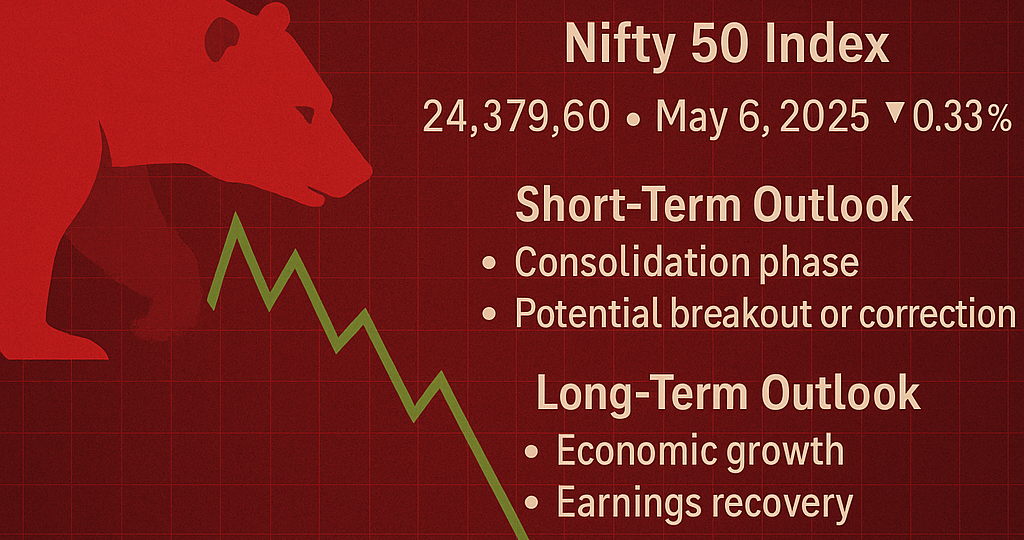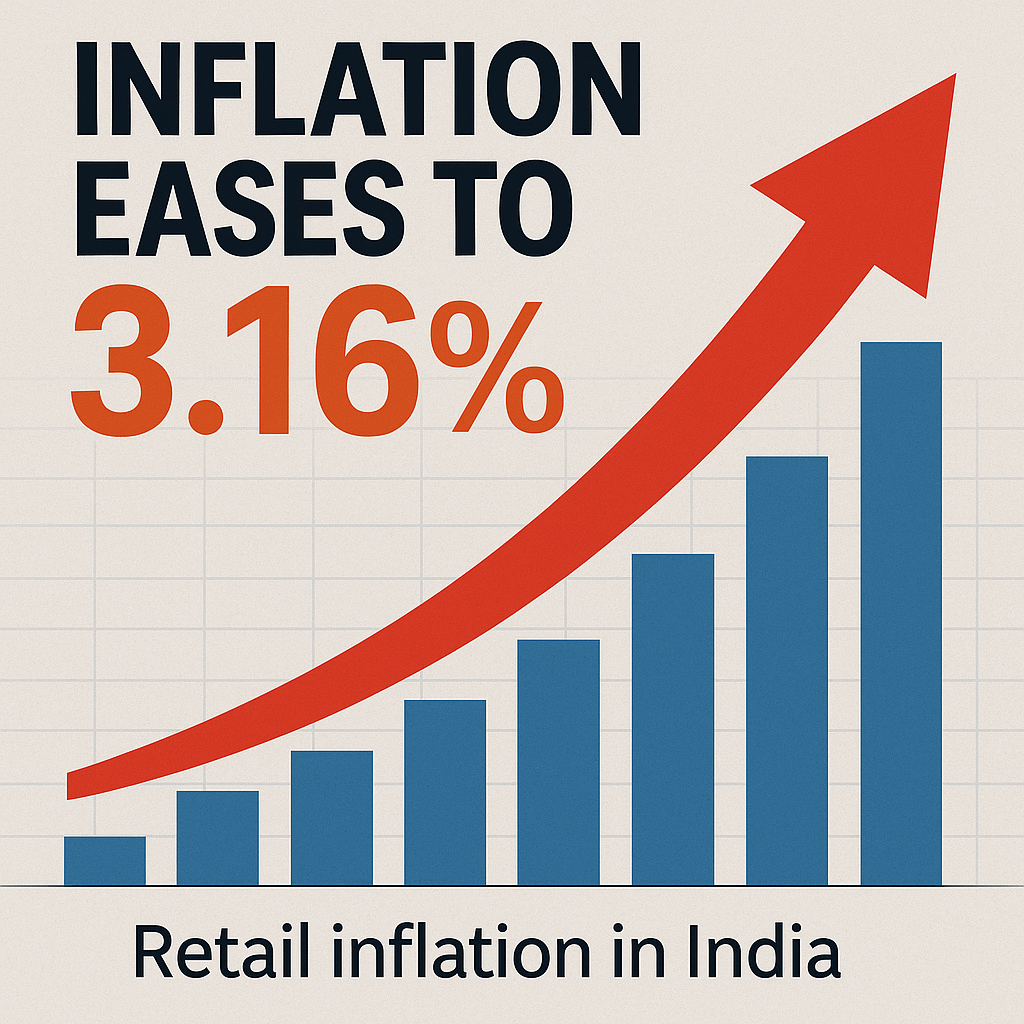Understanding the Bearish Indian Stock Market and the Potential for a Bounce Back in 2025
May 6, 2025 | by Pushpita

The Indian stock market, often seen as a reflection of the country’s economic health, entered a cautious phase on May 6, 2025. On that day, the Nifty 50 index closed at 24,379.60, down 0.33% or 81.55 points from the previous session. While this decline was modest in percentage terms, it has sparked meaningful conversations among investors, traders, and analysts about the causes of the downturn and whether the market is positioned for recovery in the months ahead.
Why the Market Was Bearish on May 6, 2025
A closer look at sector performance reveals that most sectors, except the Auto sector, closed in negative territory. Sectors like PSU banks, real estate, and energy experienced particular weakness, with renewable energy stocks also under pressure. Heavyweight companies such as Adani Enterprises and Jio Finance were among the hardest hit, registering declines between 3% and 4.5%, dragging the Nifty 50 lower.
From a technical standpoint, the market faced significant selling pressure near the 24,500 level, a key resistance zone for the Nifty 50. Many traders saw this level as an opportunity to book profits, triggering a pullback from the recent highs. Analysts had already been noting that the Nifty would likely struggle to cross above 24,600 in the near term, and if it remained below this level, a drop toward the 24,200–24,050 range was expected.
Market breadth further amplified the bearish sentiment, with a broad-based decline across stocks. For every 16 advancing stocks, about 34 stocks were declining, indicating widespread selling. Additionally, the India VIX (volatility index) rose by 5%, signaling an uptick in market uncertainty and caution among market participants.
Can We Expect a Bounce Back?
The key question on investors’ minds is whether the market will recover soon — and both short-term technical signals and long-term fundamentals offer reasons for cautious optimism.
Short-Term Outlook: Consolidation with Breakout Potential
In the short run, the Nifty 50 has been trading in a narrow range around the 24,350–24,400 mark for several consecutive sessions. This kind of price compression often sets the stage for a decisive move, either upward or downward. Market observers point out that holding above the 24,200 level would be a positive sign, possibly paving the way for the index to retest the 24,600–24,700 zone. On the flip side, if the Nifty were to break below 24,050 — which coincides with its 200-day moving average — it could signal deeper short-term weakness, with possible tests of 23,900 or even lower levels.
For short-term traders, these levels act as important reference points. A break above resistance would likely trigger fresh buying, while a break below key supports could prompt a wave of selling. Volatility, therefore, is expected to remain elevated in the near term, making it crucial for investors to stay alert and nimble.
Long-Term Outlook: Strong Economic Backdrop
Looking beyond the short-term volatility, the Indian stock market’s long-term prospects remain promising. Several analysts and brokerage firms project that the Nifty 50 could reach levels between 25,000 and 28,800 by the end of 2025. This bullish forecast is underpinned by multiple factors.
First, India’s macroeconomic fundamentals remain robust. The country is experiencing solid GDP growth, supported by strong domestic consumption, infrastructure spending, and digital transformation. The Indian rupee has also remained relatively stable compared to other emerging market currencies, adding to the attractiveness of Indian assets.
Second, corporate earnings are expected to rebound in 2025, driven by sectors such as banking, automobiles, and manufacturing. Many companies have successfully navigated through recent global challenges, and improving profitability should help support stock prices.
Third, government policies and reforms continue to act as a tailwind for markets. Proactive measures in infrastructure development, renewable energy, and digital services are not only boosting economic growth but also providing attractive opportunities for investors across sectors.
Even though foreign institutional investors (FIIs) pulled out capital from Indian markets in 2024, partly due to global risk aversion and better returns elsewhere, there are signs that this trend may reverse as India remains one of the most promising emerging markets.
Challenges and Risks to Watch
Despite the generally positive outlook, investors should remain aware of the challenges and risks that could impact market performance.
One of the key risks is geopolitical uncertainty. Global tensions, whether in the Middle East, Eastern Europe, or the South China Sea, have the potential to disrupt financial markets and reduce investor appetite for risk.
Valuations are another concern. Some analysts argue that Indian equities are trading at elevated valuations compared to historical averages. While earnings growth can justify these valuations to some extent, any disappointment on the earnings front could lead to price corrections.
Finally, FII flows remain an important variable. A resurgence of outflows could put pressure on the market, especially if global investors rotate money toward other attractive regions or asset classes.
Actionable Insights for Investors
- Monitor Technical Levels: Keep a close watch on the Nifty 50’s support and resistance zones. Levels around 24,200 and 24,050 are critical supports, while 24,500–24,600 represent resistance. A decisive break on either side could provide clues about the market’s next big move.
- Focus on Strong Sectors: Consider adding exposure to sectors that have shown resilience, such as automobiles, and remain cautious on sectors that are underperforming, like PSU banks and real estate, until clearer trends emerge.
- Stay Informed: Track real-time updates, expert opinions, and market sentiment through reliable financial platforms and news sources. Market dynamics can change quickly, and being informed gives investors an edge.
- Seek Professional Guidance: For those unsure about navigating volatility, it’s wise to consult with certified financial advisors who can help build a portfolio aligned with individual risk profiles and goals.
Conclusion
The bearish movement in the Indian stock market on May 6, 2025, was largely a product of sector-specific weaknesses, technical selling, and heightened volatility. However, this short-term dip does not overshadow the positive structural story underlying India’s equity markets. With the Nifty 50 expected to climb to 25,000–28,800 by year-end, underpinned by strong economic growth, corporate earnings recovery, and policy support, the long-term case for Indian equities remains intact. Investors who stay disciplined, monitor key technical levels, and focus on fundamentals stand a good chance of benefiting from a potential bounce back — all while managing the unavoidable risks of a dynamic market environment.
RELATED POSTS
View all


